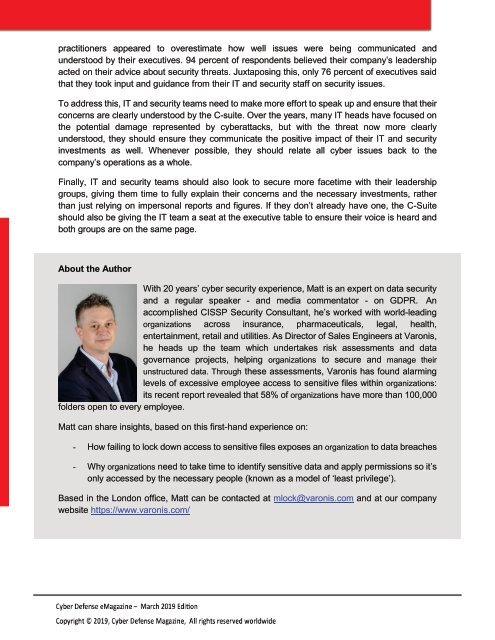CDM-CYBER-DEFENSE-eMAGAZINE-March-2019
You also want an ePaper? Increase the reach of your titles
YUMPU automatically turns print PDFs into web optimized ePapers that Google loves.
practitioners appeared to overestimate how well issues were being communicated and<br />
understood by their executives. 94 percent of respondents believed their company’s leadership<br />
acted on their advice about security threats. Juxtaposing this, only 76 percent of executives said<br />
that they took input and guidance from their IT and security staff on security issues.<br />
To address this, IT and security teams need to make more effort to speak up and ensure that their<br />
concerns are clearly understood by the C-suite. Over the years, many IT heads have focused on<br />
the potential damage represented by cyberattacks, but with the threat now more clearly<br />
understood, they should ensure they communicate the positive impact of their IT and security<br />
investments as well. Whenever possible, they should relate all cyber issues back to the<br />
company’s operations as a whole.<br />
Finally, IT and security teams should also look to secure more facetime with their leadership<br />
groups, giving them time to fully explain their concerns and the necessary investments, rather<br />
than just relying on impersonal reports and figures. If they don’t already have one, the C-Suite<br />
should also be giving the IT team a seat at the executive table to ensure their voice is heard and<br />
both groups are on the same page.<br />
About the Author<br />
With 20 years’ cyber security experience, Matt is an expert on data security<br />
and a regular speaker - and media commentator - on GDPR. An<br />
accomplished CISSP Security Consultant, he’s worked with world-leading<br />
organizations across insurance, pharmaceuticals, legal, health,<br />
entertainment, retail and utilities. As Director of Sales Engineers at Varonis,<br />
he heads up the team which undertakes risk assessments and data<br />
governance projects, helping organizations to secure and manage their<br />
unstructured data. Through these assessments, Varonis has found alarming<br />
levels of excessive employee access to sensitive files within organizations:<br />
its recent report revealed that 58% of organizations have more than 100,000<br />
folders open to every employee.<br />
Matt can share insights, based on this first-hand experience on:<br />
- How failing to lock down access to sensitive files exposes an organization to data breaches<br />
- Why organizations need to take time to identify sensitive data and apply permissions so it’s<br />
only accessed by the necessary people (known as a model of ‘least privilege’).<br />
Based in the London office, Matt can be contacted at mlock@varonis.com and at our company<br />
website https://www.varonis.com/



